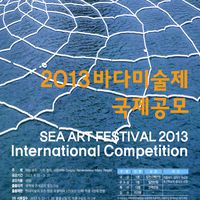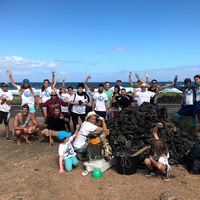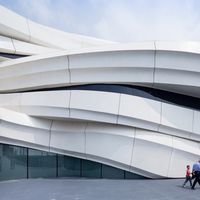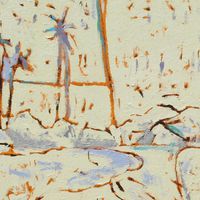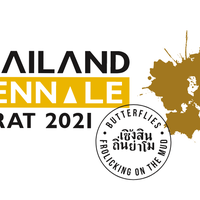#peripheries: Revitalising Krabi | Thailand Biennale 2018
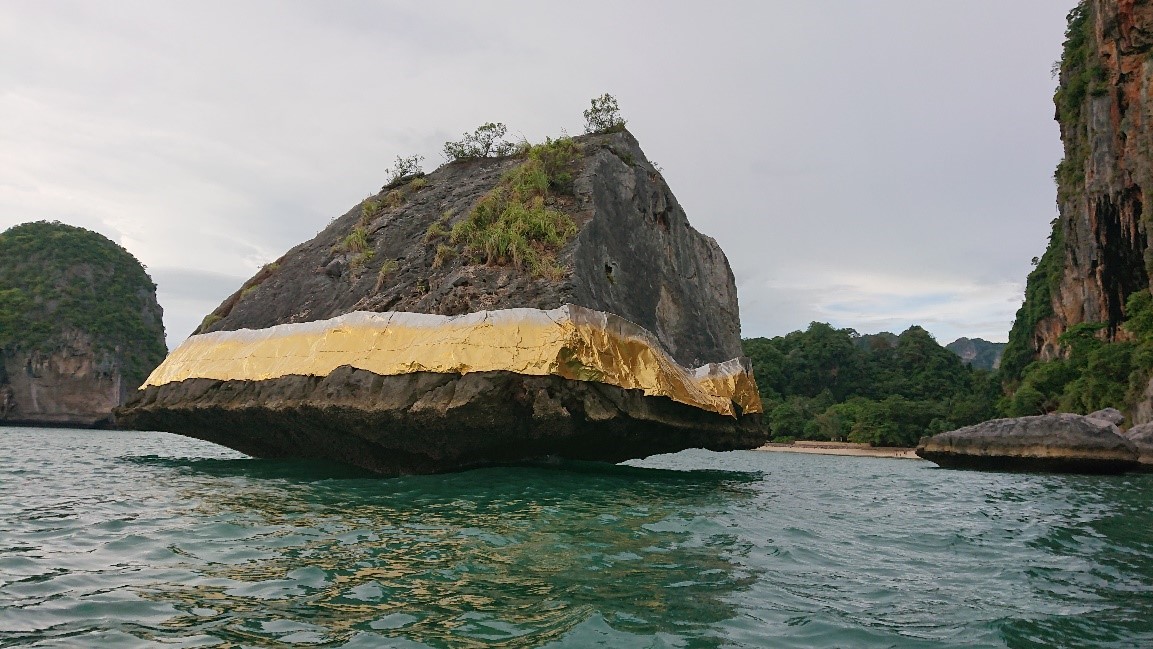
culture360.ASEF.org is featuring a new series of articles on the topic of #peripheries. The #peripheries have been regarded as being in the geographical margin, distant from the capital cities and cultural centres of countries. With an ongoing decentralisation trend, through this series of articles, we will look at various arts endeavours by artists, cultural professionals and art organisations who operate or occupy the peripheries in an urban society and the role that the arts play. In this article, Bridget Tracy Tan writes about the ground up involvement of the artists and the community in curating and selecting artworks for the Thailand Biennale 2018 held in Krabi.
Wonder reignited
The province of Krabi lies in the heart of the upper Southern coastal region of modern-day Thailand. Alongside the Andaman sea, the shorelines of Krabi are densely fortified by mangroves and mud flats, surrendering a porosity of rich exchange between the bounty of nature and the needs of the local inhabitants. “Krabi,” says Krabi Governor, Police Lieutenant Colonel Kitibodee Pravitra, “is a famous tourist destination thanks to its islands and beautiful beaches. But Krabi is more than a seaside town. From Noppharat Thra Beach, Than Bok Khorani National Park, Tha Pom Khlong Song Nam, Railay Beach to Koh Klang, these nodes of events for Thailand Biennale range from idyllic coastal landscape, waterfalls rock formations, to tight knitted communities with unique heritage.” Indeed, between 2 November 2018 to 28 February 2019, the Thailand Biennale cascaded from beyond, surging through the province right to the Edge of the Wonderland.
Navigating wonderland

Vong Phaophanit & Claire Oboussier, Gilding the Border
This work stands in the throes of the ocean, and can only be seen by hiring a boat, the longtail. The longtail is a fixture in daily Thai living: its optimal functionality limited to inland waters, declining in open seas. It heralds the network of Thai enterprise, for transport and exchange, between shorelines and along the river as well as its tributaries. In Krabi, especially during the biennale, it was the only form of transport to sites within the Andaman sea bays as cuddled by the wandering shoreline of the province. It is understood that the longtail pilots enjoyed a 30% increase in transport takings during the time of the biennale.
Laos born Vong Phaophanit and UK native Claire Oboussier are partners who work together in large scale projects and installations. Gilding the Border is their tribute to a form of deterritorialization that creates a unique access and awareness otherwise often overlooked. This part performance, part installation work involved a rock-climbing event by the two climbers that started at the top of a small island rock located in front of Phra Nang Cave beach. Propelling down in a spiral, a long, thick gold leaf plate was applied by the climbers around the base of the rock. As the tide rises naturally to submerge the rock face, water gently laps against the mirrored surface. The golden border creates an intriguing threshold between land, sea and the motions of the universe.
Works such as that by Phaophanit and Oboussier invited an exploration in Krabi beyond the usual tourist icons and sites. Chancing upon the work by boat, it captures attention from a distance. The gold is immediately apprehended, articulating cultural and social symbolisms and sensibility. The artwork embodies a sculptural and monumental dimension that invokes history, heritage, myth, ritual and life itself.
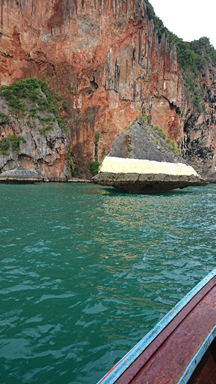
Chancing upon Gilding the Border by longtail around the cave mouth
Evensong at the edge
Like the longtail as a local craft and tool, bamboo has long been used by the Thais in constructing seawalls to protect their coasts against savage and unpredictable erosions. At the end of a jetty facing Phang-nga Bay, French sound artist, Felix Blume’s installation looked unassuming and could almost be mistaken for a structural part of coastline protection. A closer look reveals the bamboo to be flutes lodged in the seabed.
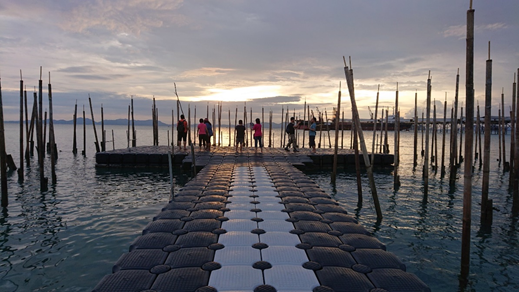
Rumours from the Sea, Khlong Muang, Krabi
Rumours from the Sea is Blume’s tribute to the needs of preservation, local Thai resource management and resilience, as well as a nod to the industry and old age convention in the use of naturally found materials to aid the enterprise. Working with Baan Khlong Muang school students, Blume supervised the fabrication of these flutes used for the installation. At the site along the beach of Khlong Muang, the water compels the air through the flute structures, creating a whistling and harmonic siphon that is differentiated through the many pieces installed. There is nothing sensational or musical in the sounds. By turns, the combined pitches raise and lower, in tandem with the movement of the sea. If you dared, lying down flat on the jetty offered the best experience of the work. You look up to where the sea meets the land, the earth moves as the sounds escape and fill the sky.

The writer on her back on the jetty
“Two roads diverged in a wood”
Under the same sky shared by Koh Klang, Greek artist Valentina Karga’s installation Coming Community is represented by 4 totem like structures along the beach. In choosing the site, the artist carefully removed the existing plants and shrubs to yield more space, replanting them elsewhere to minimize disruption to the living and vital biodiversity. The 4 totems symbolize 4 villages, 3 of which are old, 1 of which is new.

Valentina Karga’s Coming Community situated on a ‘reclaimed’ beach of Koh Klang
Karga spent a month on Koh Klang, a Muslim community that makes up 33% of Krabi’s religious profile, considered substantial within a largely Buddhist Thailand. She began by collecting natural sea debris, mostly shells and organic detritus. During her time with the community, she uncovered stories, symbols and all manner of sharing, soulfully expressed by the inhabitants of Koh Klang. Her ambition was to distil what values any community might have that will crystallise their bonds through times of global flux and uncertainty. The 4 totems here were fabricated through shaping and firing at a nearby pit outside of Koh Klang; in part brick, in part ceramic from crushed detritus, the surfaces marked by the members of the community using symbols they created for themselves. When we arrived, a local villager stood and shared many stories of the process, pointing out the tiniest of marks on the pillars, proudly conveying what each meant in reflection of the inhabitants of Koh Klang.

Cropped view of the tops of two totems from Coming Community
The Thailand Biennale called to art as a making of beautiful things, but also art as catalytic statements and observations on the socio-cultural and even political concerns native to a location. Some might argue that Krabi does not need revitalizing, for its tourist attraction and revenues contribute greatly to national coffers. But Thailand takes its cultural and natural resources seriously, in consideration of how research and undertakings will benefit the population and preservation of its earthly largesse for posterity.
The works open a dialogue amongst what Krabi Governor, Police Lieutenant Colonel Kitibodee Pravitra refers as the ‘tight knitted communities with unique heritage’. Here is not a general statement but a truth that acknowledges the many unspoken stories of individuals, livelihood, the passing of time and the expectation of the future. Bringing together the spectrum of artists from around the world and the residents of Krabi, the Thailand Biennale has yielded more than just a biennale for global or aesthetic appreciation. In a spiritual and activated revitalisation process, the artworks remarkably respond to both history and the present, distilled and alive at the global threshold, on the edge of the land, ever at the edge of wonder.
This article is written by Bridget Tracy Tan, Director for the Institute of Southeast Asian Arts and Art Galleries at Nanyang Academy of Fine Arts. Formerly a curator at the Singapore Art Museum (now National Gallery Singapore) she graduated 1996 with a Master of Arts, obtaining First Class Honours in Art History from the University of Glasgow in Scotland. Her PhD was obtained from Chelsea College of Art, UAL, in practice-led research as a curator and critical art historian. The thesis critically explored Southeast Asian museology and Southeast Asian curating in contemporary paradigms that extend into global platforms, specifically, biennales. She was invited to Krabi for the Thailand Biennale to lecture and accompany post-graduate students for field research as part Chulalongkorn University’s Masters of Arts in Cultural Management Programme.
Further reading and references
1. Thailand Biennale Krabi 2018: Edge of the Wonderland – Short Guide, Office of Contemporary Art and Culture, Thailand
2. http://www.nationmultimedia.com/detail/national/30355122 last retrieved 27 June 2019
3. https://www.siam2nite.com/en/magazine/lifestyle/item/918-the-first-thailand-biennale-international-art-festival-set-to-be-hosted-in-krabi last retrieved 27 June 2019
4. https://www.thairath.co.th/news/local/south/1398477 English translation version last retrieved 27 June 2019
5. https://www.thairath.co.th/lifestyle/life/1410148 English translation version last retrieved 27 June 2019
Similar content
deadline
20 May 2013
posted on
15 May 2019
By Laura Shen
06 Oct 2019
from - to
02 Feb 2012 - 29 Mar 2012
from - to
18 Dec 2021 - 31 Mar 2022

